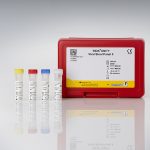Intended use:
For in vitro diagnostic use. The RIDA®UNITY Parasitic Stool Panel II test, performed on the RIDA® UNITY platform, is a multiplex real-time PCR for the direct qualitative detection of Giardia lamblia, Cryptosporidium spp., and Entamoeba histolytica DNA in untreated human stool samples from persons with signs and symptoms of gastrointestinal infection.
The RIDA®UNITY Parasitic Stool Panel II test is intended to support the differential diagnosis of parasitic infections (Giardia lamblia, Cryptosporidium spp., and Entamoeba histolytica) in patients with symptoms of gastrointestinal infection in connection with other clinical and laboratory findings.
Negative results do not rule out a parasitic infection (Giardia lamblia, Cryptosporidium spp., and Entamoeba histolytica) and should not be used as the sole basis for diagnosis.
The product is intended for professional use.
General information:
Giardia lamblia, Cryptosporidium spp., and Entamoeba histolytica are among the most important protozoa that cause diarrhea.
Globally, Giardia lamblia, also known as G. intestinalis or G. duodenalis, causes diarrheal diseases, also called giardiasis. About 500,000 new cases are reported every year. The prevalence of giardiasis ranges from 2% to 7% in industrialized countries, and from 20% to 30% in developing countries. Infection occurs through the ingestion of cysts in contaminated water or food, or through the fecal-oral route. Acute giardiasis develops after an incubation period of 15 to 30 days and usually lasts 1 to 3 weeks. Symptoms of acute infection are mushy, foul-smelling diarrhea, abdominal pain, bloating, nausea, and vomiting. There are, however, also chronic cases and even asymptomatic carriers.
Cryptosporidium parvum is one of several species of the genus Cryptosporidium. C. parvum and C. hominis are some of the most common causes of cryptosporidiosis in humans and are responsible for more than one million deaths a year. However, infections caused by other Cryptosporidium spp., such as C. felis, C. meleagridis, C. canis, and C. muris, can also lead to clinical symptoms. In the period from
2009 to 2017, a total of 444 outbreaks of cryptosporidiosis were reported in the USA, resulting in 7465 cases, 287 hospitalizations, and 1 death. Infection occurs primarily through the ingestion of oocytes containing sporozoites in contaminated water and food, and through fecal-oral transmission from human to human. Symptoms of cryptosporidiosis range from asymptomatic cases to serious watery diarrhea, as well as abdominal pain, nausea, and fever. The infection dose at which 50% of those exposed are infected, is low at 10-1,000 oocytes. In immunocompetent persons, the symptoms last for a total of about 1 to 2 weeks. Persons with immunodeficiencies, such as HIV patients, may experience a much more severe, longer, and potentially life-threatening case of cryptosporidiosis. In such cases, the course of the disease depends on the degree of weakness of the immune system.
Entamoeba histolytica is the only human-pathogenic species in the genus Entamoeba and causes infections of the gastrointestinal tract, which are also called amebiasis. Infection occurs via the fecal-oral route through the ingestion of cysts in contaminated water and food, but it can also be spread from person to person. Every year, about 50 million infections occur, resulting in 40,000 to 110,000 deaths. About 90% of infections are asymptomatic. In symptomatic cases, symptoms can develop within 2 to 4 weeks and include diarrhea, abdominal pain, and fever, as well as severe diseases, such as amebic granuloma (ameboma), which is defined as a mass that formed in the colon.
Accessories:
| Art. No. | UN1725 |
|---|---|
| Test format | real-time PCR with 96 reactions |
| Shelf life | 24 month after production |
Dear customers,
we have started to provide the documents for our products in an electronic format. These are the Instructions for Use (IFU), the Safety Data Sheets (SDS) and the Certificate of Analysis (CoA). For batches placed on the market after 01 January 2023, you can find our documents on the eIFU portal eifu.r-biopharm.com.










